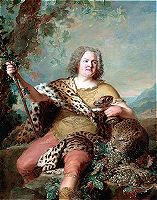 click to enlarge |
Portrait of an Aristocratic Youth as Bacchus(possibly Duc de Chaulnes)Artist: Jean-Marc Nattier SN 380, oil on canvas From: "The Pages"
|
ARTIST:
Jean-Marc Nattier came from a large family of painters, including both parents and his brother. He was trained by his father and godfather, and attended classes at the Academie Royale in Paris. In 1717 he was received into the Academie as a history painter; however, material necessity dictated his pursuit of a career as a portrait painter.
Although he worked in the tradition of the dominant portrait painters of the previous generation, he introduced mythologic attributes and a classicizing costume, which justified the chic state of undress of the fashionable sitter. This flattering, idealized portrait type remained in vogue for nearly two decades.
He painted for the French court of Louis XV, commissioned to paint many family members – including Mme de Pompadour. (Nattier painted her as Diana, a portrait now in the Cleveland Museum of Art.)
Nattier was highly successful for most of his life, but died ill and in poverty at the age of 71 after his style of painting fell out of demand.
SUBJECT:
In this portrait, we see a stocky young man wearing an unusual costume: knee-length pink tights with jeweled cuffs, knee-high boots, a tunic, and a leopard skin draped over his shoulder. He is seated on a ledge, in a relaxed pose. In his right hand he holds a staff, in his left a gold cup. The robust complexion of his face is highlighted, his expression bemused. The rosy cast of the sky in the background indicates that it is dusk.
Is this a tongue-in-cheek portrait painted for the family salon? No…it’s typical of French court portraiture of the first half of the 18th century, during the reign of Louis XV. Portraits of the aristocracy playing at gods and goddesses or other classical characters were the rage. Here the sitter is portrayed as Bacchus, holding his cup of wine & his thyrsos (grapevine stock). In ancient times Bacchus was often portrayed in a chariot drawn by tigers, leopards, or goats. Thus we see the leopard lolling at the sitter’s side and looking out at the viewer.
PAINTING:
Nattier excelled in painting rich surface textures, and here his skill is evident. Note how the supple leopard’s fur contrasts with the glossy grapes, and the blue-green delicate texture of the foliage. Also typical of the Rococo style of this period are the pastel colors, lack of architectural references, and the handling of the horizon. Trees are shown as foliage, without trunks. Body posture is angled one way, while the subject’s head turns the other way.